Cigar Spirits: Balcones 1 Texas Single Malt Whisky
4 Dec 2012
Does “single malt†and “Texas†sound strange to you? It certainly does to me. But with my Texas roots (nearly half of my family lives in the state) I figured it would be worth a shot—even with a price tag just under $70.
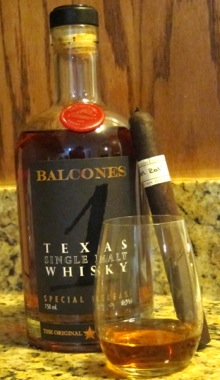 Plus, it’s not like Balcones Distillery hasn’t won any awards. In addition to being named “American Craft Distillery of the Year†by Whisky Magazine, their various spirits have racked up accolades including a handful of prizes for this single malt from the Lone Star State.
Plus, it’s not like Balcones Distillery hasn’t won any awards. In addition to being named “American Craft Distillery of the Year†by Whisky Magazine, their various spirits have racked up accolades including a handful of prizes for this single malt from the Lone Star State.
On their website, Balcones describes their “1†Texas Single Malt, which was first released in 2011, like this: “A unique style of malt whisky, Texas made, Texas proud. This product is born of hundreds of years of distilling tradition transformed by a deep sense of place. Mellow notes of sautéed pears and ripe fruit mixed with a lingering toasty malt character.â€
With all that in mind, I got down to business to try this 106-proof creation from the Waco, Texas-based operation. “1†Texas Single Malt is a medium copper color. The nose is surprisingly traditional (scotch-like), with burnt sugar, dried fruit, and a little oak barrel and vanilla.
On the palate, it has a rum-like sweetness (not that unlike the Edradour 10 I recently wrote about), along with roasted pecans, grain, and maltiness. The finish is short and leaves the mouth a bit dry, while anticipating the next sip.
Complex, yet surprisingly classic, the “1†Texas Single Malt is best paired with a mild or medium-bodied cigar. I’d particularly recommend a Connecticut-wrapped Davidoff Grand Cru or E.P. Carrillo New Wave Connecticut.
photo credit: Stogie Guys

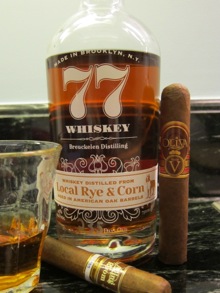 Breukelen is made in Sunset Park, barely a mile from the neighborhood where I grew up. While I hadn’t heard of the operation until I saw it in a Park Slope wine shop, the distillery seems to have cut its teeth making small batch boutique gin and, more recently, moving into whiskey.
Breukelen is made in Sunset Park, barely a mile from the neighborhood where I grew up. While I hadn’t heard of the operation until I saw it in a Park Slope wine shop, the distillery seems to have cut its teeth making small batch boutique gin and, more recently, moving into whiskey.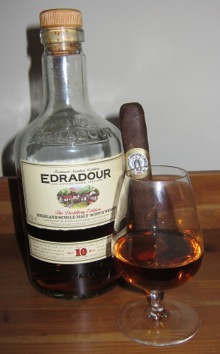 Edradour is billed as “Scotland’s smallest distillery” and the numbers support the claim, although recently even smaller distilleries have opened. Edradour is a three-man operation (though I read they recently are down to two) and it produces only 95,000 liters per year, or 12 casks a week. (By comparison, Glenlivet, the best-selling scotch in the U.S., produces just under 6 million liters a year.) Interesting fact: With 100,000 visitors a year, Edradour is almost certainly the only whisky distillery in Scotland with more visitors than liters produced per year.
Edradour is billed as “Scotland’s smallest distillery” and the numbers support the claim, although recently even smaller distilleries have opened. Edradour is a three-man operation (though I read they recently are down to two) and it produces only 95,000 liters per year, or 12 casks a week. (By comparison, Glenlivet, the best-selling scotch in the U.S., produces just under 6 million liters a year.) Interesting fact: With 100,000 visitors a year, Edradour is almost certainly the only whisky distillery in Scotland with more visitors than liters produced per year.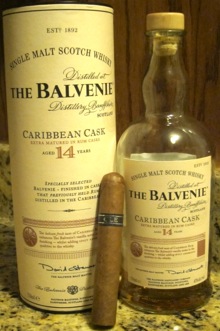 Introduced in 2010 as a U.S.-only release, the 14 Year Caribbean Cask Balvenie sells for around $60. It’s a bit more expensive than their 12 year Doublewood (an
Introduced in 2010 as a U.S.-only release, the 14 Year Caribbean Cask Balvenie sells for around $60. It’s a bit more expensive than their 12 year Doublewood (an 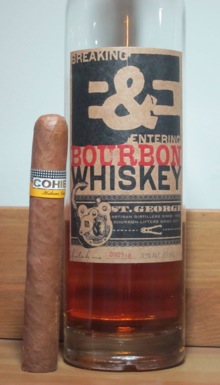 Dubbed a “super-bourbon,” B&E is the result of blending approximately 80 different barrels of bourbons from different sources all ranging from five to eight years in age. Through what they call “barrel thieving,” Saint George selects their favorite barrels from various Kentucky distilleries, then blends them together.
Dubbed a “super-bourbon,” B&E is the result of blending approximately 80 different barrels of bourbons from different sources all ranging from five to eight years in age. Through what they call “barrel thieving,” Saint George selects their favorite barrels from various Kentucky distilleries, then blends them together.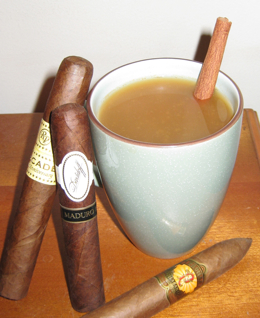 Hot Toddy — A classic that can be made with scotch (save the single malt, use a blend), bourbon, or even brandy. It’s simple to make. Just add sugar, lemon, and cloves to boiling water and your spirit. Hot toddies pair well with Connecticut-wrapped, milder cigars.
Hot Toddy — A classic that can be made with scotch (save the single malt, use a blend), bourbon, or even brandy. It’s simple to make. Just add sugar, lemon, and cloves to boiling water and your spirit. Hot toddies pair well with Connecticut-wrapped, milder cigars.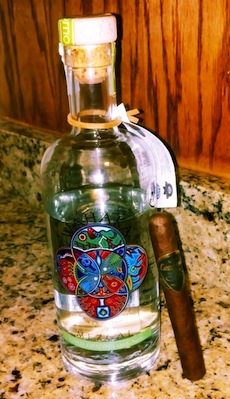 Most people, if they’ve heard of mezcal at all, think of it as bad tequila. The reputation comes because inexpensive mezcal often includes a worm at the bottom of the bottle, a marketing gimmick designed, one can only imagine, to attract frat boys on spring break in Mexico who prove their toughness by drinking poor quality mezcal. But mezcal need not be harsh, cheap, or gimmicky, and Wahaka Mezcal is proof.
Most people, if they’ve heard of mezcal at all, think of it as bad tequila. The reputation comes because inexpensive mezcal often includes a worm at the bottom of the bottle, a marketing gimmick designed, one can only imagine, to attract frat boys on spring break in Mexico who prove their toughness by drinking poor quality mezcal. But mezcal need not be harsh, cheap, or gimmicky, and Wahaka Mezcal is proof. Patrick Ashby
Co-Founder & Editor in Chief
Patrick Ashby
Co-Founder & Editor in Chief Patrick Semmens
Co-Founder & Publisher
Patrick Semmens
Co-Founder & Publisher George Edmonson
Tampa Bureau Chief
George Edmonson
Tampa Bureau Chief